Dive: The Medes Island Secret Review
|
|
See PixlBit's Review Policies

On 09/13/2010 at 03:11 PM by Nick DiMola 2D Endless Ocean this game is not. |

If players are looking to get a WiiWare game, Dive is not the worst way they could spend their points, but many of the other options on the service would be a better choice.
At first glance, players will immediately draw parallels between Dive: The Medes Island Secret and Nintendo's Endless Ocean series. While exploration and treasure recovery play a big part in both titles, the methods of doing so in both are drastically different as is the core gameplay and camera perspective. Unfortunately, Dive: The Medes Island Secret doesn't quite match up to the experiences found in the Endless Ocean series either.
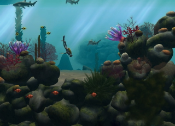
Dive: The Medes Island Secret allows players to take control of a diver looking for treasures in a 2D oceanscape. Through the use of the Wii pointer, players will direct the diver while using the B button to push him forward. While navigating the waters, looking for sparkling dots of treasure, the air in the tanks of the diver will slowly deplete.
The underwater fauna in these parts are aggressive, constantly looking to pop out from holes and attack or directly rush and corner. In order to avoid their attacks, which depletes precious oxygen, players are given a boost ability. This ability will often quickly move players out of danger, but will consume more oxygen to execute. Furthermore, much of the plantlife in the game is also dangerous, as bumping into it will cause a significant oxygen loss.
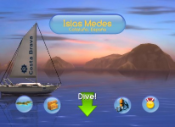
The second line of defense given to players is a tranquilizer spear gun that will repel enemy attacks. By default players are only given five projectiles, so they must pick up ammo refills in order to keep using the defensive weaponry.
To counteract the constant loss of oxygen, players will find strategically placed air canisters, as well as checkpoint life balloons which completely replenish the diver's O2 supply. In case of death, players will be moved back to the last checkpoint (or the beginning of the level), but won't lose any of the treasures collected in the level.
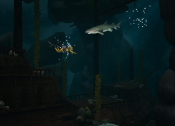
As players find treasure throughout the levels, they will be awarded a certain amount of money per item. The three large treasures in a level net the greatest amounts, typically $1000+, while the smaller treasures (about forty per level) average out to be a little over $100 each. This money can be spent between levels on upgrading gear to reach new depths, swim faster, have more air, and carry a bigger flashlight and more ammo. This is a neat system that keeps players interested in finding the most treasure each time they are out.
Dive is a sound game concept that encourages exploration, provides a thrill of collection, and ample challenge throughout. Unfortunately, a number of missteps in execution prevent Dive from being a standout title.
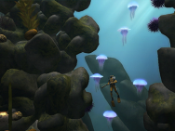
First and foremost, the way damage is dealt to the character within the game is very frustrating. In most situations, if players happened to get cornered by an enemy, regardless of oxygen supply, they can basically expect to die. This is due to a lack of knockback and temporary invincibility; two basic 2D gaming concepts that have been incorporated into games as far back as the NES.
In numerous instances I found myself in an enclosed space with an enemy fish which caused massive damage to my character instantly, due to losing the pointer on screen or simply navigating myself into a bad spot. Bumping into plantlife has the same devastating effect. With the lack of knockback, players may brush up against something harmful and not be able to escape quickly enough to salvage the majority of their life. These situations become increasingly frustrating since after getting hurt, players are still losing oxygen just to get around, and air tanks are widely spread apart. While this does encourage players to tread lightly, it simply feels unfair when these instances occur.
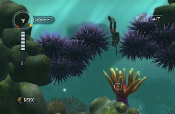
Navigating the diver is also a frustrating experience and one that is without option. Because the former issue requires such precision, the pointer hardly feels like the most accurate way to move the character around on the screen. It would've been nice to plug in the Classic Controller, Nunchuk, or even just flip the Wii Remote on its side to navigate the waters, and it definitely would've had the precision necessary to limit error.
While these issues are frustrating, the worst offender is the game's lack of longevity. About three or four levels in, players will begin to realize that the game doesn't offer much variety. While the graphics are fairly impressive for a WiiWare game, they start to lose their luster when you see the same level pieces used around every corner. The same goes for the music; while great at first, the same track seems to repeat itself unendingly. Both of these provide for some very consistently similar levels that stop being interestingly fairly quickly.
For all of its negatives, Dive does manage to be fairly interesting for at least a level or two. If Cosmonaut decides to revisit this concept for a sequel, I can only hope that they expand the scope of the title and bring it to a disc where they have more room to create a more varied experience. What's found in Dive is decent for what it is, but players will likely grow bored or frustrated with it fairly quickly.







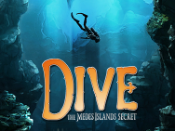


Comments